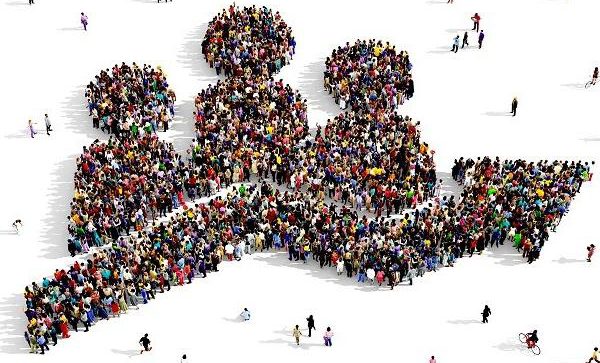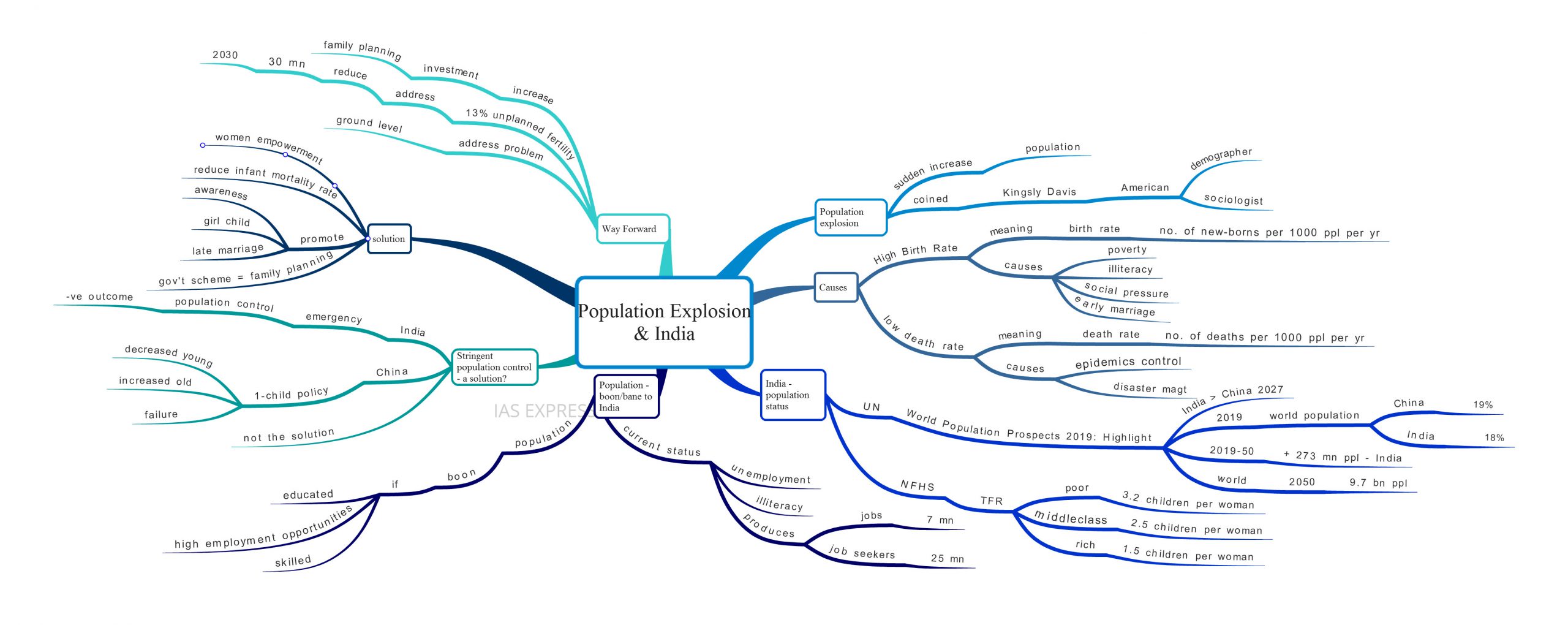Population Explosion – A Stark Reality in India

From Current Affairs Notes for UPSC » Editorials & In-depths » This topic
IAS EXPRESS Vs UPSC Prelims 2024: 85+ questions reflected
* First published: August, 2019; Last Updated: November 2022
Prime Minister Narendra Modi, in his Independence Day speech, addressed the problem of population explosion in India. He termed those who opt for smaller families as patriots. He argued that the development and prosperity of the nation begin only when all the individuals are healthy and resourceful. He appealed for the public effort to reduce the population at the ground level. This speech comes with the backdrop of the UN Population Projections report that estimated that India will be the most populous country in the world through the current century.

What is the population explosion?
- Population explosion is the sudden increase in the size of the population.
- This term was coined by the American Sociologist, Kingsley Davis.
- If the trend of high population growth is left unchecked, there will be several repercussions like unemployment, poverty, poor standards of living, a larger gap between the rich and the poor, lesser resources, greater exploitation of natural resources, etc.
What are the causes of population explosion?
In India, the causes of overpopulation are as follows:
- High Birth Rate:
- Meaning: Birth rate is the number of new-borns per thousand persons in a year.
- Causes: The causes of the high birth rate are as follows:
- Poverty: Many poor families consider their children as assets. This is because children can help support the family’s income by working at an early age.
- Illiteracy: Many people are not aware of the consequences of overpopulation.
- Social pressure: Many families feel that male children are essential. Therefore this increased the birth rate exponentially.
- Early marriage: Many individuals are pressured into marriage by society at a very early age. This also contributes to the overpopulation.
- Low Death Rate:
- Meaning: Death rate is the number of deaths per thousand persons in a year.
- Causes: The causes of the low death rate:
- Improved management of epidemics: The high death rates are mainly caused due to epidemics. Enhanced medical facilities in both urban and rural areas have highly contributed to the low mortality rate. With the improvement of medical technologies and life-saving drugs, the task of reducing the mortality rate has become easier.
- Disaster Management: The advancement of early warning systems and evacuation procedures has contributed to the decline of death rates caused by natural and man-made disasters.
Is India overpopulated?
- India is currently the second-most populous country in the world after China.
- According to the UN report, World Population Prospects 2019: Highlights, India is estimated to surpass China as the world’s most populous country in the world by 2027.
- This report was published by the Population Division of the UN Department of Economic and Social Affairs.
- According to this report, there will be an additional 273 million people between now and 2050 in India.
- India is said to remain the most populous country through the end of the current century
- This report also stated that the world’s population may increase by 2 billion people in the next thirty years i.e., from the current 7.7 billion to 9.7 billion in 2050.
- The previous UN reports too had predicted that India will surpass China as the world most populous county in the world.
- As of 2019, China has 1.43 billion people while India houses 1.37 billion individuals.
- In other words, China and India hold 19 and 18 percent of the world population respectively as of 2019.
- However, according to the National Family Health Survey, India’s population growth is not uniform.
- In India, the Total Fertility Rate differs across various wealth quintiles.
- The poorest wealth quintile has a total fertility rate of 3.2 children per woman.
- The second-lowest wealth quintile has a TFR of 2.5 children per woman.
- The richest quintile has TFR of 1.5 children per woman.
- This shows that population growth is high only in the economically weaker section of the Indian society.
Is population a boon or a bane to the Indian economy?
- A population can be an asset if the youth of the country has access to education, skill development, increased employment opportunities, etc.
- However, currently, India faces a very high unemployment rate.
- Many in the Indian population are illiterate and don’t have access to education.
- It is estimated that India is currently producing 25 million job seekers but provides jobs to only 7 million.
- If this is not addressed soon, the Indian population may become a liability.
- The current government is bearing the burden of providing the access to clean drinking water, houses, cooking fuel, electricity, and healthcare to the whole of the Indian population and is aiming to create a $5trillion economy.
- Also, India’s landmass is only 35-40% of China’s landmass.
- India cannot sustain the current rate of population growth due to the limited geographical area.
- If these crises are not addressed soon, India may face various negative repercussions like poverty, pollution, poor standard of living, etc.
Is harsh population control a solution?
- Both India and China had experimented with stringent population control measures.
- China’s One-Child Policy had increased the proportion of old population while it simultaneously decreased the younger population.
- India, during the Emergency, had undertaken similar measures to reduce India’s population.
- This policy faced scathing criticism from the world and has not been tried since by any of the governments since.
What are the solutions to counter overpopulation?
Certain measures can be taken to address the overpopulation. They are as follows:
- Encouraging late marriages: Many in Indian society opt for early marriages due to various reasons like social pressures, traditions, etc. If late marriages become the norm, it will considerably reduce the birth rate.
- Spreading awareness: It is essential to spread awareness among the public about the negative consequences of the overpopulation. This can be done through education, public forums, media, etc. It is essential to provide free education to women at least till the college level so that they need not be dependent on their male counterparts for survival and are willing to participate in the workforce.
- Reduction of infant mortality rate: It is essential to bring down the infant mortality rate. This is because, due to high infant mortality rates, many opt for increased birth rate to offset the loss.
- Women empowerment: Women must be empowered through education, skill development, financial inclusion so that they can become independent and free from the shackles of the social norms and constraint.
- Government schemes on par with efficient family planning: Many opt for having children for the purpose of security during the later stage of life. If the government provides enough security through increased welfare schemes for the older population, people will opt for far lesser children.
- Promotion of the girl child: India is a society where the male child has far more importance than their female counterparts. Therefore many families tend to continue having children until a male child is born. Government policies must focus on the increased promotion of female children to address this problem. Beti Bachao, Beti Padhao scheme is a step in the right direction.
Way Forward:
- India has 13% of unwanted fertility – the product of unwanted or unplanned pregnancy, mainly due to the lack of education, awareness, family planning services, etc.
- If this issue is addressed, India will have 30 million lesser people by 2030.
- The government must increase its investment in the health sector. Currently, India invests only 1.3% of its total GDP on the health sector of which only 4% is dedicated to family planning.
- The government must address the issue at the ground level as the population growth rate differs at various parts of the country due to the social, cultural and economic diversity of India.
Updates
Population Growth: According to the UN World Population Prospects (WPP), 2022, India will surpass China as the most populous country by 2023, with a population of 140 crore. India currently accounts for 17.5% of the global population.
- This is four times the population of India when it gained independence in 1947. (34 crore).
- India is expected to reach 150 crore by 2030 and 166 crore by 2050.
Decline in India’s Total Fertility Rate (TFR): In 2021, India’s TFR fell below the replacement level fertility (2.1 children per woman) to two. India had a TFR of six in the 1950s, following independence.
Except for Bihar, UP, Jharkhand, Manipur, and Meghalaya, several states have achieved a TFR of two.
The main reasons for this are high illiteracy rates, widespread child marriage, high under-five mortality rates, low female labor-force participation, lower contraceptive use, and a lack of economic and political power among women.
Improvements in Mortality Indicators:
- Life expectancy at birth increased from 32 years in 1947 to 70 years in 2019.
- Infant mortality fell from 133 in 1951 (for the big states) to 27 in 2020.
- The under-five mortality rate fell from 250 in the 1940s to 41 in 2019, while the maternal mortality ratio fell from 2,000 in the 1940s to 103 in 2019.
If you like this post, please share your feedback in the comments section below so that we will upload more posts like this.



Very good 👍😊 sir
Super
Very nice sir